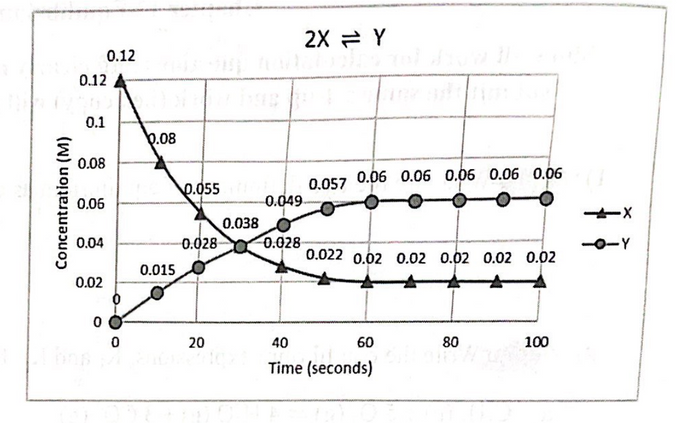6) For a given equilibrium system, 2X = Y, use the graph to the right to determine which statement(s) below is/are true. Circle all that apply. Concentration (M) 0.12 A 0.1 0.08 0.06 0.04 0.12 0.02 0 0 0.08 0.015 a. The reaction has reached equilibrium at 60 seconds. b. There are more reactants than products at equilibrium. c. K> 1 for this reaction. d. The value of K, is 3. 0.055 0.028 20 0.038 0.049 0.028 2X = Y 0.057 0.06 0.06 0.06 0.06 0.06 -0- 0.022 0.02 0.02 0.02 0.02 0.02 + 40 60 Time (seconds) 80 100 -X -0-Y
6) For a given equilibrium system, 2X = Y, use the graph to the right to determine which statement(s) below is/are true. Circle all that apply. Concentration (M) 0.12 A 0.1 0.08 0.06 0.04 0.12 0.02 0 0 0.08 0.015 a. The reaction has reached equilibrium at 60 seconds. b. There are more reactants than products at equilibrium. c. K> 1 for this reaction. d. The value of K, is 3. 0.055 0.028 20 0.038 0.049 0.028 2X = Y 0.057 0.06 0.06 0.06 0.06 0.06 -0- 0.022 0.02 0.02 0.02 0.02 0.02 + 40 60 Time (seconds) 80 100 -X -0-Y
Chemistry
10th Edition
ISBN:9781305957404
Author:Steven S. Zumdahl, Susan A. Zumdahl, Donald J. DeCoste
Publisher:Steven S. Zumdahl, Susan A. Zumdahl, Donald J. DeCoste
Chapter1: Chemical Foundations
Section: Chapter Questions
Problem 1RQ: Define and explain the differences between the following terms. a. law and theory b. theory and...
Related questions
Question

Transcribed Image Text:6)
For a given equilibrium system,
2X = Y, use the graph to the right
to determine which statement(s) below is/are
true. Circle all that apply.
7).
anonsuma Lopinated wahallo) ob
Concentration (M)
0.12
0.1
0.08
0.06
0.04
0.12
0.02
0
00
0
0.08
0.015
a. The reaction has reached equilibrium at 60 seconds.
b. There are more reactants than products at equilibrium.
c. K> 1 for this reaction.
d. The value of K, is 3.
0.055
-0.028
20
0.038
0.049
0.028
2X = Y
0.057
0.06 0.06 0.06 0.06 0.06
ad
0.022 0.02 0.02 0.02 0.02 0.02
40
Time (seconds)
60
80
100
Which one of the following statements about the equilibrium constant, K₂, is false?
a. An is equal to the sum of the coefficients of the gaseous products minus the sum of the
coefficients of the gaseous reactants.
An
b. The relationship between K, and K. is: K₂= K. (RT) LES GE
с
c. No units are reported with K, values.
d. K. is usually larger than K₂.
Expert Solution
Step 1
To identify the correct statement regarding the equilibrium of the reaction .
The concentration of reactant and product versus time graph is given as follows.

"Since you have asked multiple questions, we will solve the first question for you. If you want any specific question to be solved then please specify the question number or post only that question.”
Trending now
This is a popular solution!
Step by step
Solved in 4 steps with 1 images

Knowledge Booster
Learn more about
Need a deep-dive on the concept behind this application? Look no further. Learn more about this topic, chemistry and related others by exploring similar questions and additional content below.Recommended textbooks for you

Chemistry
Chemistry
ISBN:
9781305957404
Author:
Steven S. Zumdahl, Susan A. Zumdahl, Donald J. DeCoste
Publisher:
Cengage Learning

Chemistry
Chemistry
ISBN:
9781259911156
Author:
Raymond Chang Dr., Jason Overby Professor
Publisher:
McGraw-Hill Education

Principles of Instrumental Analysis
Chemistry
ISBN:
9781305577213
Author:
Douglas A. Skoog, F. James Holler, Stanley R. Crouch
Publisher:
Cengage Learning

Chemistry
Chemistry
ISBN:
9781305957404
Author:
Steven S. Zumdahl, Susan A. Zumdahl, Donald J. DeCoste
Publisher:
Cengage Learning

Chemistry
Chemistry
ISBN:
9781259911156
Author:
Raymond Chang Dr., Jason Overby Professor
Publisher:
McGraw-Hill Education

Principles of Instrumental Analysis
Chemistry
ISBN:
9781305577213
Author:
Douglas A. Skoog, F. James Holler, Stanley R. Crouch
Publisher:
Cengage Learning

Organic Chemistry
Chemistry
ISBN:
9780078021558
Author:
Janice Gorzynski Smith Dr.
Publisher:
McGraw-Hill Education

Chemistry: Principles and Reactions
Chemistry
ISBN:
9781305079373
Author:
William L. Masterton, Cecile N. Hurley
Publisher:
Cengage Learning

Elementary Principles of Chemical Processes, Bind…
Chemistry
ISBN:
9781118431221
Author:
Richard M. Felder, Ronald W. Rousseau, Lisa G. Bullard
Publisher:
WILEY